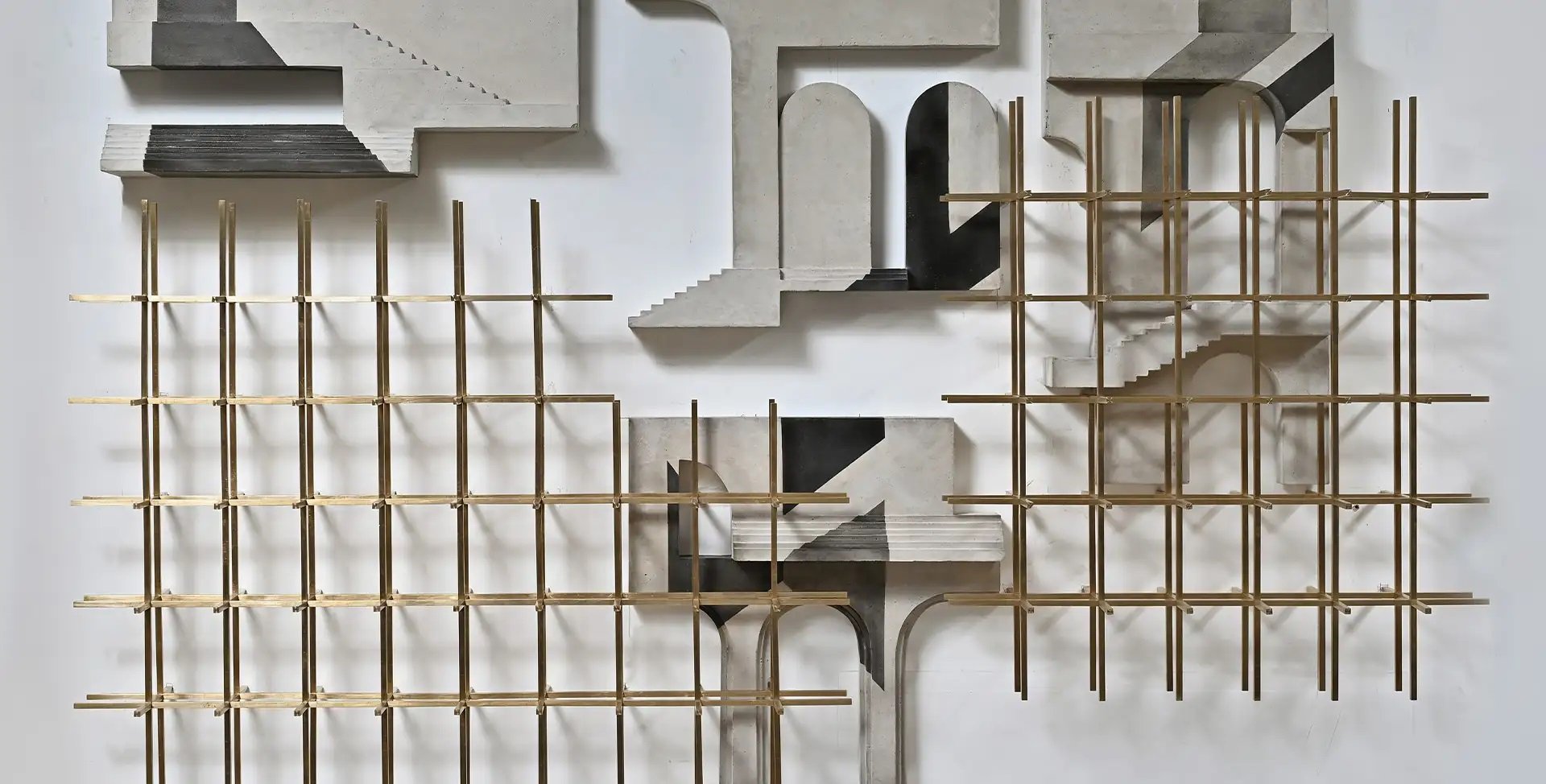REVIEW: Living Memories in Lived Spaces: Rathin Barman’s Unsettled Structures at the Arts Club of Chicago
“Unsettled Structure VI”, 2023. Brass and charcoal on concrete. Courtesy of the Artist and Experimenter. Photo: Nepal Bhadra.
REVIEW
Rathin Barman’s Unsettled Structures
Arts Club of Chicago
201 E. Ontario Street
Chicago IL 60611
September 19—December 22, 2023
By Xiao daCunha
Do you remember your childhood home? The small kitchen table everyone gathered around, the vintage oak cupboard with Victorian moldings your grandma bought when she got married, or the giant flower quilt you wrapped yourself in every night?
What about the first apartment you rented as you hunted for a job after college? The historic brick walls and marble decors left from decades ago, the tiny stairwell with marks left by people moving furniture in and out, or the cozy book nook you built yourself based on a Pinterest post?
We enter, exist, and interact with various architecture throughout our lives, from private residences to public buildings. Our living experience manifests in the spaces we live in, whereas the space redefines and alternates our experience and perception simultaneously. As a result, architecture becomes cultural, memorial, and archival, carrying on a collective narrative even long after its tenants’ departures.
“Unsettled Structure II,” 2023. Brass and charcoal on concrete, 48.25 x 36 x 6.5 inches. Courtesy of the Artist and Experimenter. Photo: Nepal Bhadra.
In Unsettled Structures, on view at the Arts Club of Chicago through December 22, India-based architect and artist Ratchin Barman explores architecture from an anthropological perspective, drawing inspirations from private and collective memories to create a multi-layered experience transcending beyond historic architecture and reflecting the constant sense of unsettlement as individuals continue to adjust, adapt, and accommodate their living spaces and those they share the space with. The series of works in the exhibition is the collective result of oral histories, repeated visits to the living space over a decade, and direct, extensive interactions with the sites and the materials and elements compositing the architecture.
Several pieces in the exhibition originated from the legacy of colonial mansions in Kolkata, India, Barman’s hometown. Specifically, the “Unsettled Structure” series created assemblages using brass and concrete to recreate the mansions’ definitive architectural elements, such as arched hallways and brass girds. The artist then drew with charcoal on top of the cement blocks, using light and dark to construct secondary structures atop the existing modules, encouraging the viewers to rebuild the 3D architecture in their own ways.
Installation image of Unsettled Structure by Rathin Barman at The Arts Club of Chicago. Image courtesy of the Arts Club.
For his exhibition at The Arts Club of Chicago, Barman intended for his pieces to activate the gallery space. Hence, the physical experience becomes definitive of how the pieces in the exhibition are perceived.
The narrative-setting piece for the Arts Club exhibition is a massive brass grid gateway structure sitting in the middle of the gallery floor. As viewers walk around, peek through, or step into the structure, their perception of the exhibition space shifts accordingly. How does the space interact with the works on display as brass bars segment it into small sections, blocking, sectioning, and even distorting the view? Does a different perspective reveal previously undiscovered features in the space, or does it suggest an alternative movement pattern through the establishment?
As the viewers ask these questions, their role evolves from being an outside observer of foreign architecture to a current tenant whose choices shape the experience within the building.
“Re-Structured Living Space” | 2021. Charcoal and pigment on brass inlaid concrete, 240 x 128 x 1 inches, 120 cast concrete panels, each 16 x 16 x 1 inches/Image courtesy: Rathin Barman, Experimenter Contemporary Art and Queensland Gallery of Modern Art/10th Asia Pacific Triennial Photo: Nepal Bhadra.
In the post-pandemic era, where human connections await to be rebuilt, Barman’s interrogation of the grand mansions carries significant relevance. Meanwhile, his anthropological approach to architecture tolls a wakening bell as our population faces one of the severest housing crises in history.
In an interview with New City Design, Barman mentioned that “the grand mansions, often occupied only partially, appeared disoriented to me amidst the newly designed domestic spaces that catered to smaller families.” Essentially, architecture should serve human beings, and aesthetics must negotiate with functionality to provide a grounded, efficient, and relevant experience for those residing within. Combining the artist’s experience in engineering, architecture, and art, Unsettled Structures urges its viewers to reconsider the relationship human beings have with their residences. How do we interact with our surroundings? Why do we structure our home the way we do? What do we carry with us as we move from one site to another, and what do humans collectively leave behind as we enter and exit a building?
Installation image of Unsettled Structure by Rathin Barman at The Arts Club of Chicago. Image courtesy of the Arts Club.
Like other metropolitans in the US, Chicago also struggles with affordable housing, homelessness, and a shortage of space. For the past few years, Chicago has invited architects, engineers, and artists for passionate debates regarding how architecture can aid the human living experience, from developing new values from existing materials to finding more humanitarian ways to utilize space, hoping to find a solution and experiment with new possibilities. Amidst the 5th edition of the Chicago Architecture Biennial and soon after the conclusion of this year’s Open House Chicago, Unsettled Structures reminds us to regard architecture as an anthropological product.
In the end, the people who resided in the building and their independent and collective stories mattered. As we discuss community redevelopment and historic building preservation, we must realize we are also cultivating fertile soil for human growth while preserving histories, memories, and narratives embedded into the building as residents come and go.
Xiao daCunha is a writer and artist living in Chicago and Kansas City, Missouri.
Like what you’re reading? Consider donating a few dollars to our writer’s fund and help us keep publishing every Monday.







